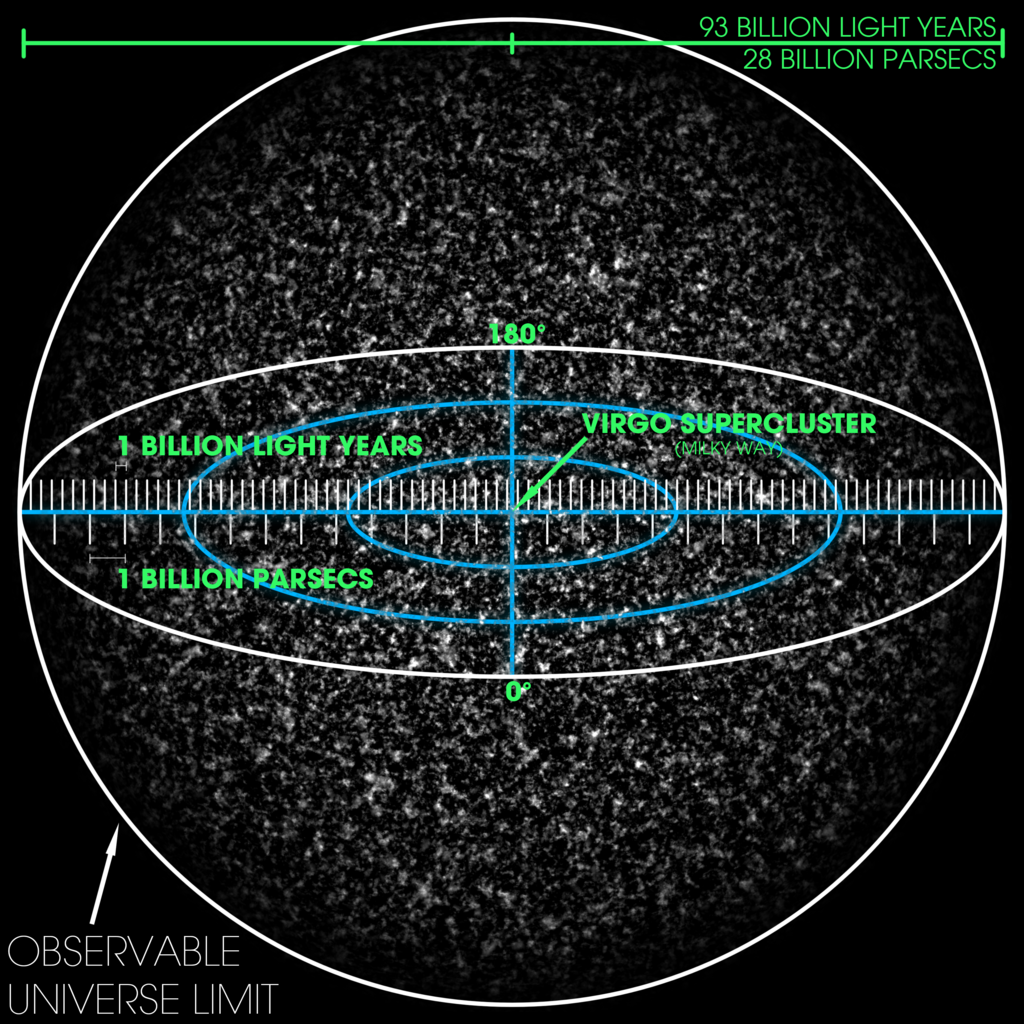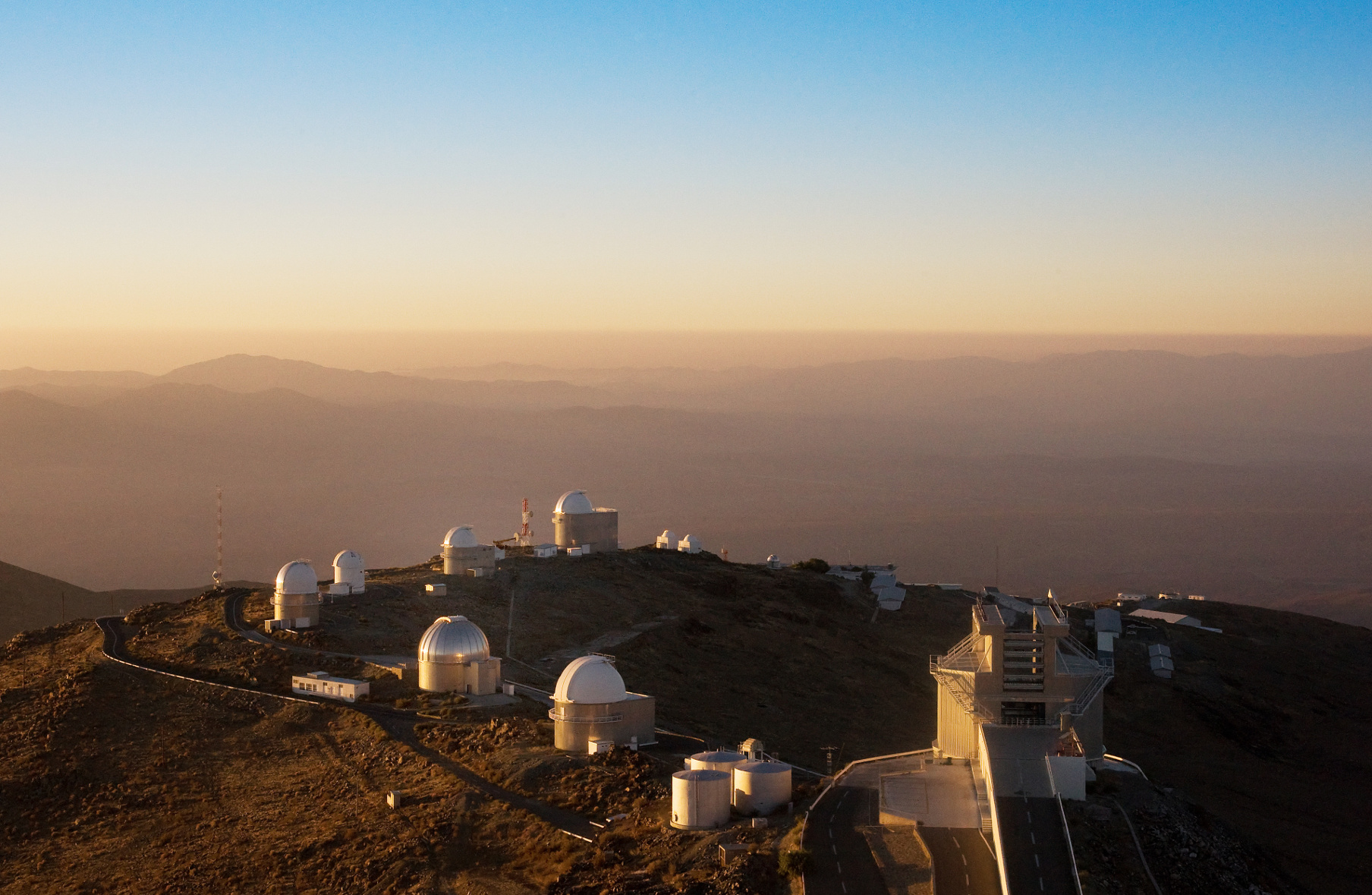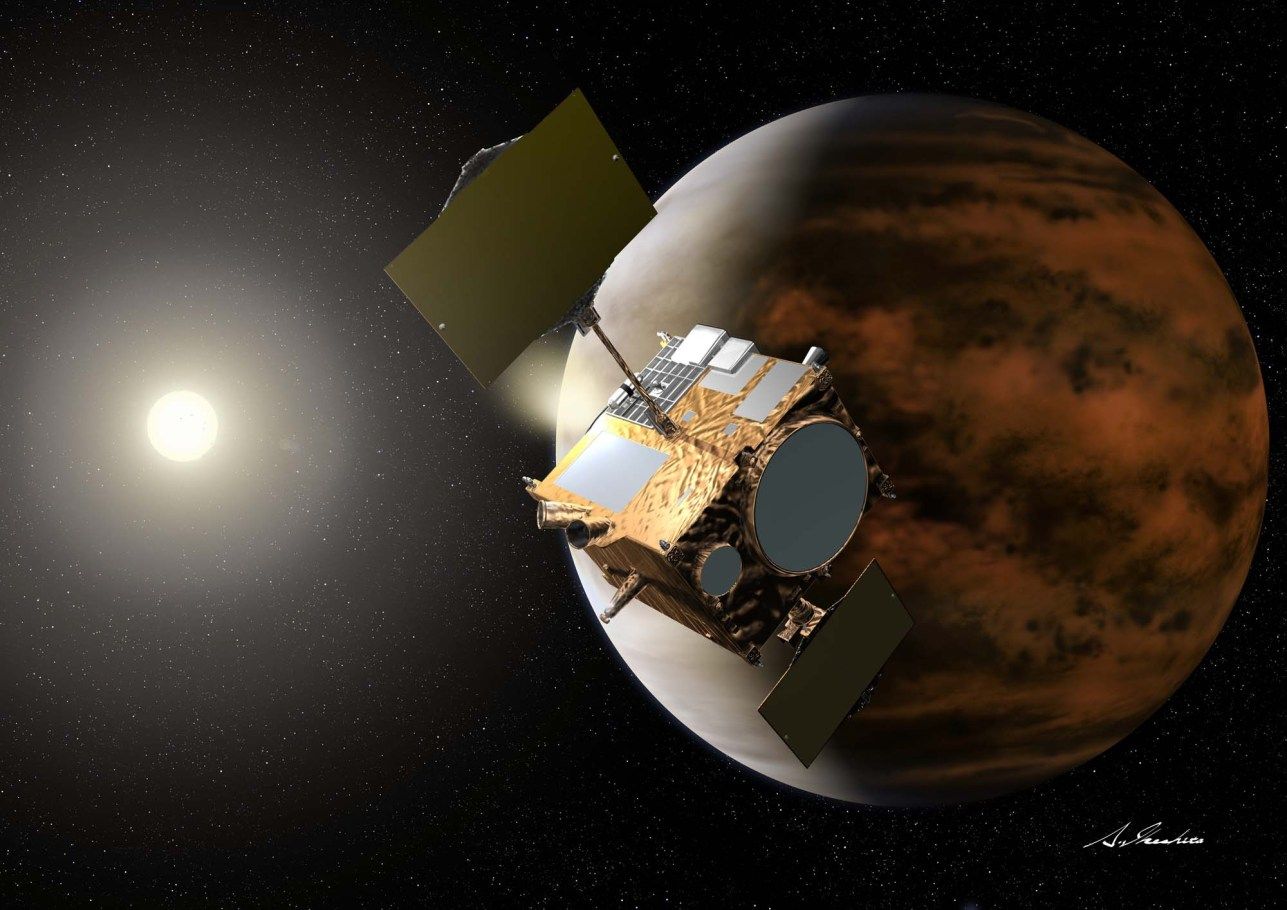
漢德百科全書 | 汉德百科全书
 Astronomy
Astronomy





可观测宇宙(observable universe)是一个以观测者作为中心的球体空间,小得足以让观测者观测到该范围内的物体,也就是说物体发出的光有足够时间到达观测者。截至2013年对宇宙年龄最精确的估计是137.98±0.37 亿年。[5] 但由于宇宙的膨胀,可观测宇宙的半径并不是固定的138亿光年,人类所观测的古老天体当前的距离比起其原先的位置要遥远得多(以固有距离(proper distance)来衡量,固有距离在现在的时点和同移距离是相等的)。[7] 现在推测可观测宇宙半径约为465亿光年,直径约为930亿光年。[8][9] 根据宇宙学原理,从任何方向到可观测宇宙边缘的距离大致是相等的。
“可观测”在这个意义上与现代科技是否容许我们探测到物体发出的辐射无关,而是指物体发出的光线或其他辐射可能到达观测者。实际上,我们最远只能观测到宇宙从不透明变为透明的临界最后散射面(surface of last scattering),但在未来的技术下,我们有可能观测到更古老的宇宙中微子背景辐射,甚至可能能够从引力波的探测推断这个时间之前的信息。有时候天体物理学家将“可视宇宙”(visible universe)和“可观测宇宙”相区分,前者只包括了再复合时期以来的信息而后者则包括了自宇宙膨胀(传统宇宙学的大爆炸及现代宇宙学的暴胀时期结束)以来发出的信息。经过计算,到CMBR粒子的同移距离(可视宇宙的半径)大约为140亿秒差距(约457亿光年),而到可观测宇宙边缘的同移距离大约为143亿秒差距(约466亿光年)[10],大约比前者大2%。
ビッグバン宇宙論でいう観測可能な宇宙(かんそくかのうなうちゅう、observable universe)とは、中心にいる観測者が領域内の物体を十分に観測できるほど小さい、つまり、ビッグバン以後のどの時点でその物体から放出された信号であっても、それが光速で進んで、現在の観測者のもとに届くまでに十分な時間があるような球状の空間領域である。宇宙のどの場所にもその場所にとっての観測可能な宇宙があり、それは地球を中心とするものと重なる部分も重ならない部分もある。 「観測可能」という語は、現代の技術でこの領域内の物体から放射されたエネルギーが検出できるかどうかとは無関係であり、その物体からの光やその他の放射エネルギーが地球上の観測者のもとに到達することが原理上可能だという意味である。実際に観察できるのは、宇宙が晴れ上がった「最終散乱面」にある物体までである。晴れ上がる前の宇宙は、光子に対して不透明であった。しかしながら、重力波(やはり光速で移動している)の検出によって、それ以前の情報を推定することもできないわけではない。重力波はインフレーション時代の遅くとも後期から発生しており、それによって数兆光年・あるいはそれ以上の遠方の宇宙を観測できる可能性がある(もちろんインフレーション時代の宇宙の姿の観測となる)。The observable universe is a spherical region of the universe comprising all matter that can be observed from Earth or its space-based telescopes and exploratory probes at the present time, because electromagnetic radiation from these objects has had time to reach the Solar System and Earth since the beginning of the cosmological expansion. There are at least 2 trillion galaxies in the observable universe.[8][9] Assuming the universe is isotropic, the distance to the edge of the observable universe is roughly the same in every direction. That is, the observable universe has a spherical volume (a ball) centered on the observer. Every location in the universe has its own observable universe, which may or may not overlap with the one centered on Earth.
The word observable in this sense does not refer to the capability of modern technology to detect light or other information from an object, or whether there is anything to be detected. It refers to the physical limit created by the speed of light itself. Because no signals can travel faster than light, any object farther away from us than light could travel in the age of the universe (estimated as of 2015 around 13.799±0.021 billion years[5]) simply cannot be detected, as the signals could not have reached us yet. Sometimes astrophysicists distinguish between the visible universe, which includes only signals emitted since recombination (when hydrogen atoms were formed from protons and electrons and photons were emitted)—and the observable universe, which includes signals since the beginning of the cosmological expansion (the Big Bang in traditional physical cosmology, the end of the inflationary epoch in modern cosmology).
According to calculations, the current comoving distance—proper distance, which takes into account that the universe has expanded since the light was emitted—to particles from which the cosmic microwave background radiation (CMBR) was emitted, which represents the radius of the visible universe, is about 14.0 billion parsecs (about 45.7 billion light-years), while the comoving distance to the edge of the observable universe is about 14.3 billion parsecs (about 46.6 billion light-years),[10] about 2% larger. The radius of the observable universe is therefore estimated to be about 46.5 billion light-years[11][12] and its diameter about 28.5 gigaparsecs (93 billion light-years, 8.8×1026 metres or 2.89×1027 feet).[13] The total mass of ordinary matter in the universe can be calculated using the critical density and the diameter of the observable universe to be about 1.5 × 1053 kg.[14] In November 2018, astronomers reported that the extragalactic background light (EBL) amounted to 4 × 1084 photons.[15][16]
As the universe's expansion is accelerating, all currently observable objects will eventually appear to freeze in time, while emitting progressively redder and fainter light. For instance, objects with the current redshift z from 5 to 10 will remain observable for no more than 4–6 billion years. In addition, light emitted by objects currently situated beyond a certain comoving distance (currently about 19 billion parsecs) will never reach Earth.[17]
L'Univers observable est un terme utilisé en cosmologie pour décrire la partie visible de notre Univers. Par définition, c'est une boule dont la limite est située à l'horizon cosmologique, et dont la Terre constitue le centre. C'est donc une notion relative, et d'autres observateurs situés ailleurs dans l'Univers n'auront pas la même boule observable (mais son rayon sera le même).
Du fait que notre Univers ait un âge fini, 13,8 milliards d'années, la lumière des objets célestes situés au-delà de l'horizon n'a pas eu le temps de parvenir jusqu'à nous et ces objets sont donc invisibles ; néanmoins, l'Univers observable s'agrandit par nature au cours du temps : le rayon de l'Univers visible est ainsi une seconde-lumière plus grand chaque seconde ou de manière équivalente une année-lumière plus grand chaque année, et même plus en tenant compte de l'expansion de l'Univers.
Les objets les plus éloignés de l'Univers observable sont également les plus jeunes et les plus proches du Big Bang, car ce sont ceux dont la lumière a mis le plus de temps à parvenir à l'observateur. Ils sont également perçus avec un décalage vers le rouge d'autant plus grand que l'objet est éloigné.
In cosmologia l'universo osservabile è una regione di spazio racchiusa da una sfera centrata su un osservatore, sfera che contiene tutto ciò che egli può osservare. Generalmente si intende la porzione di universo indagabile dall'uomo, quindi la sfera centrata sulla Terra, ma ogni posizione nello spazio possiede il suo universo osservabile.
Se l'Universo non fosse in continua espansione, il raggio dell'universo osservabile sarebbe pari alla distanza percorsa dalla luce nell'arco di tempo trascorso dall'inizio dell'Universo (l'età dell'universo), cioè l'orizzonte dell'universo osservabile sarebbe posto a circa 13,8 miliardi di anni luce; poiché però l'universo si sta espandendo continuamente, la distanza effettiva di questo orizzonte è più grande: una radiazione elettromagnetica partita 13,8 miliardi di anni fa che giungesse ora ad un osservatore sarebbe relativa a una sorgente che nel frattempo si è allontanata dall'osservatore a causa dell'espansione. Alcune stime ipotizzano che lo spazio si potrebbe essere espanso per circa 46,5 miliardi di anni luce (4,7×1023 km).[1][2] Sulla base di questa stima, il diametro della sfera dell'universo osservabile sarebbe pari a 93 miliardi di anni luce[3]; il volume di questo spazio sferico è pari a circa 5×1032 anni luce cubi; queste dimensioni potrebbero contenere circa 7×1022 stelle, organizzate in circa 2x1012 galassie (duemila miliardi, secondo una stima effettuata nel 2016)[4], agglomerate in gruppi e ammassi di galassie e superammassi. Osservazioni condotte col Telescopio Spaziale Hubble suggeriscono un numero medio di galassie ancora maggiore.
Per quanto riguarda la parte osservabile, nelle zone più distanti dall'osservatore la recessione (allontanamento) avviene a velocità superluminali; inoltre l'espansione risulterebbe, da un certo punto della vita dell'universo in avanti, in accelerazione. Ciò non permette alla luce emessa oggi dagli oggetti che si trovano in questo momento oltre la distanza di Hubble di raggiungerci, poiché in queste regioni più remote lo spazio si dilata più velocemente della velocità della luce e incrementa la sua velocità di dilatazione. Ciò crea un orizzonte degli eventi di un buco nero; se si aggiunge la relazione tra spazio e tempo ad oggi considerata valida e la fenomenologia dei buchi neri, in questo orizzonte dell'universo una stella, particella o informazione avvicinandosi al limite, apparirà all'osservatore rallentare, fino ad arrestarsi dopo un tempo infinito sull'orizzonte dove il tempo è zero. Oltre l'orizzonte dell'universo, posto alla distanza di Hubble oggi pari a 46,5 miliardi di anni luce[5] dall'osservazione, leggi fisiche, spazio e tempo perdono contatto causale, cioè non esisterà mai la possibilità di osservare o scambiare con queste regioni alcun segnale o informazione generato d'ora in avanti. In pratica queste regioni escono dalla realtà dell'osservatore e quindi, di fatto, "al di fuori" del suo universo.
El universo observable, horizonte del universo u horizonte cosmológico constituye la parte visible del universo total. Parece tener un espacio-tiempo geométricamente plano. Tiene un radio de 1,37 x 1026 m, un volumen de 1,09 x 1079 m3 y una masa de 9,27 x 1052 kg, por lo que la densidad masa-energía equivalente es de 8,46 x 10-27 kg/m3. La densidad media de sus constituyentes primarios es de un 68,3 % de energía oscura, un 26,8 % de materia oscura fría y un 4,9% de materia ordinaria, según datos recogidos por la sonda Planck. Así, la densidad de los átomos está en el orden del núcleo de hidrógeno sencillo para cada cuatro metros cúbicos.1 La naturaleza de la energía oscura y la materia oscura fría sigue siendo un misterio. Aunque se han propuesto diferentes candidatos para ambas cosas (como partículas y fuerzas ya existentes o nuevas, o modificaciones de la relatividad general) no existe confirmación experimental sobre ninguna de las propuestas.
Наблюда́емая Вселе́нная — понятие в космологии Большого взрыва, описывающее часть Вселенной, являющуюся абсолютным прошлым относительно наблюдателя. С точки зрения пространства, это область, из которой материя (в частности, излучение, и, следовательно, любые сигналы) успела бы за время существования Вселенной достичь нынешнего местоположения (в случае человечества — современной Земли), то есть быть наблюдаемой. Границей наблюдаемой Вселенной является космологический горизонт, объекты на нём имеют бесконечное красное смещение[1]. Число галактик оценивается более чем в 500 млрд[2].
Часть наблюдаемой Вселенной, доступной для изучения[3] современными астрономическими методами, называется Метагала́ктикой; она расширяется по мере совершенствования приборов[4]. За пределами Метагалактики располагаются гипотетические внеметагалактические объекты. Метагалактика может быть или малой частью Вселенной, или почти всей[5].
Сразу после своего появления Метагалактика начала расширяться[6] однородно и изотропно[7]. В 1929 году Эдвином Хабблом[8] была обнаружена зависимость между красным смещением галактик и расстоянием до них (закон Хаббла). На нынешнем уровне представлений она трактуется как расширение Вселенной.
Некоторые теории (например, большинство инфляционных космологических моделей) предсказывают, что полная Вселенная имеет размер намного больший, чем наблюдаемая.
Теоретически, граница наблюдаемой Вселенной доходит до самой космологической сингулярности, однако на практике границей наблюдений является реликтовое излучение. Именно оно (точнее, поверхность последнего рассеяния) является наиболее удалённым из объектов Вселенной, наблюдаемых современной наукой. В то же время в настоящий момент по мере хода времени наблюдаемая поверхность последнего рассеяния увеличивается в размерах, так что границы Метагалактики растут[9], и растёт, например, масса наблюдаемого вещества во Вселенной.
Наблюдаемую Вселенную можно, хотя и грубо, представлять как шар с наблюдателем в центре. Расстояния в пределах Метагалактики измеряются в терминах «красного смещения», z[10].
Ускорение расширения наблюдаемой Вселенной означает, что в природе имеется не только всемирное тяготение (гравитация), но и всемирное антитяготение (тёмная энергия), которое преобладает над тяготением в наблюдаемой Вселенной[11].
Метагалактика не только однородна, но и изотропна[12].
В гипотезе «раздувающейся Вселенной» из ложного вакуума вскоре после появления Вселенной могла образоваться не одна, а множество метагалактик (в том числе и наша)[13].
В некоторых случаях понятия «Метагалактика» и «Вселенная» приравнивают[14].

可见光和红外巡天望远镜(简称VISTA,Visible and Infrared Survey Telescope for Astronomy)是位于智利帕瑞纳天文台的一座口径4.1米的反射望远镜。它属于欧洲南方天文台,在2009年12月开光,是世界上最大的近红外巡天望远镜。[1]可见光和红外巡天望远镜只有一个仪器:VIRCAM(the Vista InfraRed CAMera),即一个重达3吨的红外相机。它由16片红外敏感的探测器组成,总像素为高达6700万。[2]
VISTA以英国伦敦大学玛利皇后学院为首的18所英国大学组成的大学联盟主导[3],是英国为履行欧南台协定而提供的,由英国科技设备委员会提供资金(STFC)。


拉马第高能太阳光谱成像探测器(缩写为RHESSI)是美国宇航局于2002年2月5日发射的一颗太阳探测卫星,主要目的是研究太阳耀斑中的粒子加速和能量释放过程。这颗卫星原名为高能太阳光谱成像探测器(HESSI),为纪念太阳高能物理领域的先驱人物鲁文·拉马第(Reuven Ramaty)而更名为RHESSI。其观测范围覆盖了从3 keV的软X射线波段到20 MeV的伽玛射线波段,并具有极高的谱分辨本领。美国宇航局戈达德太空飞行中心、美国伯克利加州大学、瑞士苏黎世联邦理工学院等机构参与了卫星的设计和建造。
Der Reuven Ramaty High Energy Solar Spectroscopic Imager (RHESSI) (auch Explorer 81) ist ein ehemaliges Weltraumteleskop der NASA mit Beteiligung anderer amerikanischer und schweizerischer Institute. Es diente zur Sonnenbeobachtung im Röntgen- und Gammabereich. In dieser energiereichen elektromagnetischen Strahlung wurden Sonnenkorona und Sonneneruptionen beobachtet und die physikalischen Mechanismen der Teilchenbeschleunigung in diesen Ereignissen (die Rekonnexion) untersucht.

Bei Laniakea handelt es sich um den lokalen Groß-Supergalaxienhaufen. Er umfasst etwa 100.000 Galaxien, darunter die Milchstraße.[1] Seine Ausdehnung beträgt 520 Millionen Lichtjahre bzw. 160 Megaparsec.[2]
ラニアケア超銀河団[1][2] (ラニアケアちょうぎんがだん、Laniakea Supercluster[3]) は、2014年に新しく提唱された超銀河団。天の川銀河が属する局部銀河群やおとめ座銀河団もその一部であり[4]、およそ10万個の銀河を含んでいる[5]。この超銀河団はハワイ州立大学のR. ブレント・タリーとリヨン大学のエレーヌ・クールトアらにより、銀河の視線速度によって銀河団の境界を定める新たな手法の発表と合わせて提唱された。この新しい超銀河団の定義は既に定義されていたおとめ座超銀河団を含んでいる[4][6][7][8]。
後の研究によると、ラニアケア超銀河団は重力による拘束を受けていないため、これらの構造を維持することはできず、いずれ分散されてしまうと予想されている[9]。
The Local Supercluster or Local SCl; also called Laniakea Supercluster (Laniakea, Hawaiian for open skies or immense heaven; sometimes Lenakaeia)[2] is the galaxy supercluster that is home to the Milky Way and approximately 100,000 other nearby galaxies. It was defined in September 2014, when a group of astronomers including R. Brent Tully of the University of Hawaii, Hélène Courtois of the University of Lyon, Yehuda Hoffman of the Hebrew University of Jerusalem, and Daniel Pomarède of CEA Université Paris-Saclay published a new way of defining superclusters according to the relative velocities of galaxies. The new definition of the local supercluster subsumes the prior defined local supercluster, the Virgo Supercluster, as an appendage.[3][4][5][6][7]
Follow-up studies suggest that the Local Supercluster is not gravitationally bound; it will disperse rather than continue to maintain itself as an overdensity relative to surrounding areas.[8]
Laniakea (« paradis incommensurable » ou « horizon céleste immense »1 en hawaïen) est le superamas de galaxies englobant le superamas de la Vierge dont fait partie la Voie lactée, et donc par suite le Système solaire et en particulier la Terre.
Sa découverte par une équipe internationale d'astronomes composée de R. Brent Tully, de l'université d'Hawaï à Mānoa, d'Hélène Courtois, de l'université de Lyon I, de Yehuda Hoffman, de l'université hébraïque de Jérusalem, et de Daniel Pomarède, du Commissariat à l'énergie atomique et aux énergies alternatives, résultant d'une nouvelle façon de définir les superamas selon les vitesses radiales des galaxies2, a été annoncée en septembre 20141.
Il Superammasso Laniakea (dall'hawaiano: Lani e Akea, Cieli Immisurabili; anche denominato solo Laniakea, o Superammasso Locale) è un superammasso di galassie in cui è compreso il Superammasso della Vergine, che contiene il Gruppo Locale con la Via Lattea e, di conseguenza, il Sistema solare con la Terra. A sua volta, il Superammasso Laniakea è compreso all'interno della struttura a filamento chiamata Complesso di Superammassi dei Pesci-Balena, che è una delle più grandi strutture conosciute dell'universo. Laniakea fu individuata nel settembre 2014, quando un gruppo di astronomi tra cui R. Brent Tully della Università delle Hawaii a Manoa e Helene Courtois della Università di Lione pubblicarono uno studio su un nuovo metodo per la definizione dei superammassi in accordo con le velocità relative delle galassie. La nuova definizione di superammasso locale riduce ora, ciò che era definito come superammasso locale, il Superammasso della Vergine, ad una mera appendice.[2][3][4][5]
Laniakea es el supercúmulo de galaxias al que pertenece nuestra galaxia, la Vía Láctea, y por lo tanto también el sistema solar y la Tierra.1 Fue definido en septiembre de 2014, cuando astrónomos de la Universidad de Hawái, liderados por Brent Tully,2 publicaron una nueva forma de definir el término de supercúmulo conforme a las velocidades relativas de las galaxias.
Ланиаке́я (также Ланиакеа[1], англ. Laniakea[2], по-гавайски — «необъятные небеса»[3]) — сверхскопление галактик, в котором, в частности, содержатся Сверхскопление Девы (составной частью которого является Местная группа, содержащая галактику Млечный Путь с Солнечной системой)[3] и Великий аттрактор, в котором расположен центр тяжести Ланиакеи[4][5].
Диаметр Ланиакеи примерно равен 520 миллионам световых лет[5]. Ланиакея состоит примерно из 100 тысяч галактик[3], движущихся совместно к некоторой области в космосе[5], а масса её примерно равна 1017 массам Солнца (примерно в 100 раз больше массы Сверхскопления Девы)[5]. Соседним с Ланиакеей является сверхскопление Персея-Рыб[6] из цепи Персея-Пегаса (входящей в Комплекс сверхскоплений Рыб-Кита). Ланиакея была выделена по согласованным траекториям галактик[1][5].





 Aerospace
Aerospace

 Alaska-AK
Alaska-AK
 Science and technology
Science and technology
 Florida-FL
Florida-FL